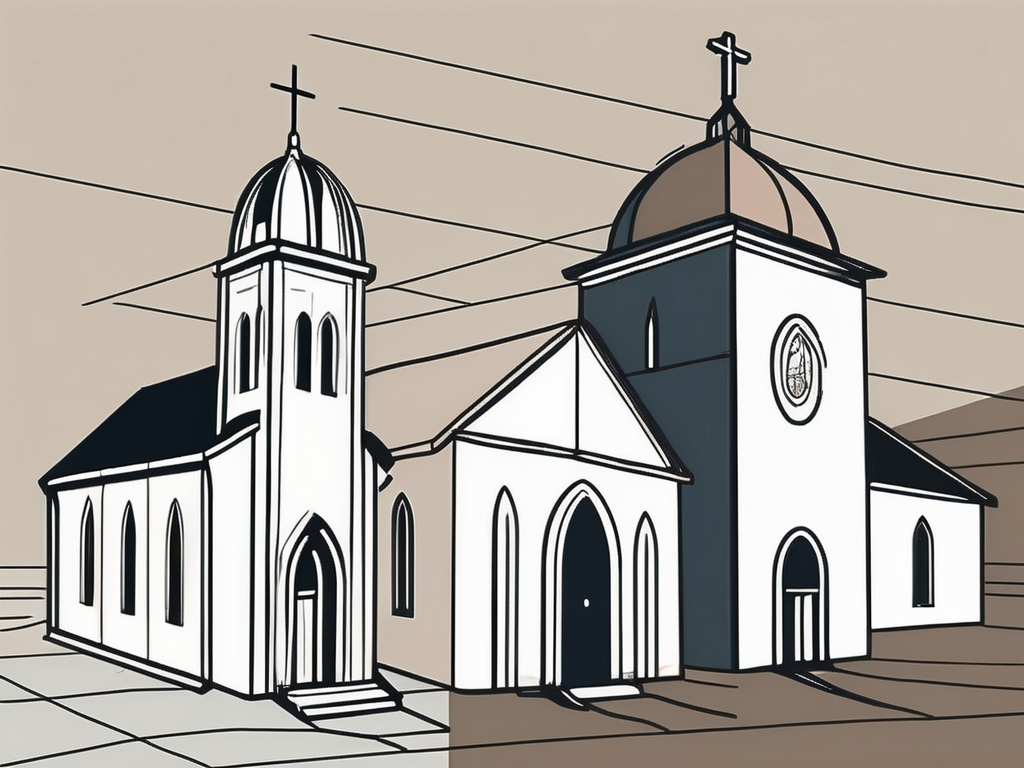In the vast tapestry of Christianity, there are numerous branches and denominations that diverge in their beliefs and practices. One such distinction lies in the comparison between Protestantism and Baptism. While they may share some similarities, there are key differences that set them apart. Let’s delve into the basics of these two branches and uncover their unique characteristics.
Understanding the Basics: Protestantism and Baptism
Defining Protestantism: A Brief Overview
Protestantism traces its origins back to the 16th century Reformation, a movement led by revolutionary figures such as Martin Luther and John Calvin. This transformative period in history challenged the authority of the Catholic Church and paved the way for a new understanding of Christianity. Central to Protestantism is the emphasis on faith and the Bible as the sole authority in matters of belief.
Protestants reject the authority of the Pope and the Catholic Church hierarchy, advocating for a direct relationship with God. This rejection of centralized authority was a radical departure from the established religious order of the time. It allowed individuals to interpret scripture for themselves and form their own conclusions about matters of faith.
Protestant denominations vary in their worship styles, but they all prioritize the individual’s personal connection with God and the understanding of scripture. This diversity is a testament to the broad spectrum of interpretations within Protestantism. From the vibrant and energetic worship of Pentecostal churches to the more traditional and contemplative services of Anglican churches, there is a wide range of expressions of faith within the Protestant tradition.
Defining Baptism: A Brief Overview
Baptism, as practiced by various Christian denominations, signifies the initiation into the faith community. It is a sacred ritual that symbolizes purification, rebirth, and the acceptance of God’s grace. However, Baptists place a unique emphasis on the act of “believer’s baptism,” which means that individuals must consciously profess their faith before being baptized.
This emphasis on believer’s baptism is rooted in the belief that baptism should be a personal and voluntary act of faith. It is a public declaration of one’s commitment to follow Jesus Christ and live according to his teachings. By choosing to be baptized, individuals affirm their belief in the saving power of Jesus and their desire to be part of the community of believers.
This contrasts with infant baptism, a common practice in many Protestant denominations. Infant baptism is based on the belief that baptism is a sacrament that cleanses the original sin inherited from Adam and Eve. It is seen as a means of God’s grace and an entry into the Christian community from an early age.
Baptists also emphasize the autonomy of local churches and the primacy of congregational decision-making. Each Baptist church functions independently, with no centralized governing body dictating theological matters. This congregational polity allows for a more democratic approach to church governance, where decisions are made collectively by the members of the church.
Furthermore, Baptists believe in the separation of church and state, advocating for religious freedom and the right of individuals to worship according to their own conscience. This commitment to religious liberty has been a defining characteristic of Baptist identity throughout history.
In conclusion, understanding the basics of Protestantism and baptism provides insight into the rich tapestry of Christian beliefs and practices. From the diverse interpretations of scripture within Protestantism to the significance of believer’s baptism in Baptist tradition, these concepts shape the way individuals experience and express their faith.
Historical Context: The Origins and Evolution
The origins and evolution of Protestantism and Baptism are fascinating subjects that shed light on the complex history of Christianity. Understanding the historical context is crucial to comprehending the development of these religious movements and their impact on society.
The Birth and Growth of Protestantism
Protestantism emerged as a response to the perceived corruption and abuses within the Catholic Church during the 16th century. Martin Luther, a German monk and theologian, played a pivotal role in igniting the Reformation with his Ninety-Five Theses. These theses were a list of grievances challenging the church’s practices, particularly the sale of indulgences.
Luther’s bold act of defiance sparked a widespread movement that questioned the authority of the Pope and emphasized the importance of individual faith and direct access to God. As the Reformation gained momentum, various reformers, such as John Calvin and Huldrych Zwingli, contributed to the development of different Protestant denominations.
Each branch of Protestantism reflects a specific interpretation of scripture and belief system. Lutheranism, for example, emphasizes salvation by grace through faith alone, while Presbyterianism places a strong emphasis on the sovereignty of God and the importance of church governance.
The Emergence and Development of Baptism
Baptism, one of the sacraments recognized by most Christian denominations, has its roots in the early days of Christianity. The practice of baptism can be found in the New Testament, where it is associated with the teachings of Jesus and the initiation of new believers into the Christian community.
However, it was during the Reformation that Baptists emerged as a distinct group with their own theological perspectives. Baptists rejected the practice of infant baptism, which was common in the Catholic Church and other Protestant denominations. They believed that baptism should be a conscious and voluntary decision made by individuals who have reached an age of understanding.
Throughout history, Baptists faced intense persecution for their beliefs. Their commitment to religious freedom and the principle of believer’s baptism, where only those who have professed faith in Jesus Christ are baptized, often put them at odds with the authorities of their time.
Today, Baptists encompass a diverse range of subgroups, each with its own nuances and traditions. Southern Baptists, for example, are known for their conservative theology and emphasis on evangelism, while Independent Baptists prioritize congregational autonomy and separation from outside influences. American Baptists, on the other hand, have a more moderate stance and focus on social justice issues.
In conclusion, the historical context of Protestantism and Baptism reveals a rich tapestry of religious, social, and political factors that shaped these movements. Exploring their origins and evolution provides valuable insights into the diverse landscape of Christianity and the ongoing pursuit of spiritual truth.
Theological Differences: Beliefs and Practices
When it comes to theological differences, Protestantism encompasses a wide range of beliefs and practices. While Protestants share some core beliefs, such as salvation by grace through faith in Jesus Christ, the trinity, and the importance of scripture, the specific interpretation of these beliefs can vary significantly from denomination to denomination.
One area where Protestants differ is in their views on sacraments. Some Protestant denominations place great importance on rituals such as communion and baptism, considering them as essential acts of worship and means of receiving God’s grace. On the other hand, there are those who focus more on personal faith and relationship with God, considering these sacraments as symbolic rather than sacramental.
Another theological difference among Protestants is their understanding of predestination and the role of good deeds in salvation. Some Protestant denominations affirm the concept of predestination, believing that God has already determined who will be saved and who will not. Others reject this notion, emphasizing the importance of free will and individual choice in accepting or rejecting God’s grace. Similarly, there are varying beliefs regarding the role of good deeds in salvation, with some denominations emphasizing the importance of good works as evidence of faith, while others emphasize salvation by faith alone.
In addition to these theological differences, Protestant denominations also vary in their beliefs regarding social issues, church hierarchy, and ecclesiastical traditions. Some denominations take strong stances on social issues such as abortion, same-sex marriage, and gender roles, while others adopt more liberal positions. Church hierarchy can also differ, with some denominations having a more centralized structure with bishops and archbishops, while others have a more congregationalist approach where decisions are made by the local church members.
Core Beliefs of Baptists
While Baptists share many core beliefs with other Christians, such as the trinity and the centrality of Jesus Christ, they also hold some unique beliefs that set them apart. These beliefs are rooted in the concepts of “soul liberty” and the autonomy of the local church.
Soul liberty is a fundamental belief among Baptists, emphasizing the individual’s freedom and responsibility to interpret scripture for themselves. This belief rejects any coercion or external authority in matters of faith, affirming the importance of personal conviction and conscience. Baptists believe that each person has the right to approach God directly and to form their own understanding of biblical teachings.
Another core belief among Baptists is the autonomy of the local church. Unlike some other denominations that have a hierarchical structure with centralized authority, Baptists emphasize the self-governance of each individual congregation. This means that decisions regarding church practices, leadership, and doctrine are made by the congregation as a whole, rather than being dictated by a higher authority. This emphasis on local autonomy allows for a greater sense of community involvement and participation in the decision-making process.
In conclusion, while there are some core beliefs that are shared among Protestants, the specific interpretation and emphasis of these beliefs can vary greatly. From sacraments to predestination, social issues to church hierarchy, each Protestant denomination brings its own unique perspective and understanding to the table. Similarly, Baptists have their own distinct beliefs, rooted in the concepts of soul liberty and the autonomy of the local church. These theological differences contribute to the rich tapestry of Protestantism and highlight the diversity within the broader Christian faith.
Worship Styles: Comparing Protestant and Baptist Services
Protestant Worship: Structure and Elements
Protestant worship services can differ greatly, as each denomination has its own traditions and practices. Generally, Protestant services revolve around congregational singing, prayer, scripture reading, and preaching. Some denominations incorporate liturgical elements, while others opt for a more casual and contemporary approach.
Protestant churches may have a structured order of service, with specific segments dedicated to praise and worship, sermon, and fellowship. The presence of sacraments, such as communion, also varies among Protestant denominations.
One of the defining characteristics of Protestant worship is the emphasis on congregational participation. In many Protestant churches, the congregation actively engages in singing hymns and worship songs. This participatory aspect creates a sense of unity and community among the worshippers.
Additionally, Protestant worship often includes a time of prayer, where individuals can express their personal needs and concerns to God. This practice of communal prayer allows the congregation to support and uplift one another.
Another important element in Protestant worship is the reading of scripture. The Bible holds a central role in Protestant faith, and the reading of scripture during worship services allows worshippers to connect with the teachings and stories of the Bible.
Furthermore, preaching plays a significant role in Protestant worship. The sermon serves as a means of teaching and guiding the congregation, providing practical applications of biblical principles to their daily lives. The pastor or preacher delivers the sermon, sharing insights and interpretations of scripture.
While some Protestant denominations follow a more structured liturgy, others adopt a more flexible and contemporary approach. In these churches, worship may include modern music styles, multimedia presentations, and interactive elements to engage the congregation.
Baptist Worship: Structure and Elements
Baptist worship services typically prioritize congregational participation and communal singing. The sermon holds great importance in Baptist worship, as it serves as a means of scriptural teaching and practical application for the congregation’s daily lives.
Unlike some Protestant denominations, Baptists generally do not have a fixed liturgy or order of service. Instead, the format can vary from church to church, often reflecting the preferences of the pastor and congregation. This flexibility allows for a more spontaneous and adaptable worship experience.
In Baptist worship, congregational singing plays a central role. Hymns and worship songs are sung collectively, creating a sense of unity and shared worship experience. The emphasis on congregational participation encourages worshippers to actively engage in praising God through music.
Similar to Protestant worship, prayer is an integral part of Baptist services. The congregation comes together to pray for various needs, including personal concerns, community issues, and global events. This communal prayer time fosters a sense of interconnectedness and solidarity among the worshippers.
While Baptists do not place as much emphasis on sacraments compared to some Protestant denominations, they still practice baptism and the Lord’s Supper. Baptism is seen as a public declaration of faith, symbolizing the believer’s identification with Christ’s death, burial, and resurrection. The Lord’s Supper, also known as communion, is a symbolic act of remembrance and thanksgiving for Christ’s sacrifice.
Furthermore, Baptist worship services often include a time for testimonies, where individuals share personal stories of faith and how God has worked in their lives. These testimonies serve as a source of encouragement and inspiration for the congregation.
In conclusion, while there are similarities between Protestant and Baptist worship services, there are also distinct differences. Both prioritize congregational participation and the teaching of scripture, but the specific elements and structure can vary. Understanding these differences can help individuals appreciate the rich diversity within the broader Christian tradition.
Role of the Church: Protestant vs Baptist Perspectives
The Protestant View on Church Authority
Protestants reject the centralized authority of the Pope and the Catholic Church hierarchy. Instead, they believe in the priesthood of all believers, highlighting the individual’s direct access to God without the need for intermediaries. The emphasis is on personal faith, Bible study, and the Holy Spirit’s guidance.
While some Protestant denominations may have a hierarchical structure within their own organization, the ultimate authority still rests with the individual’s interpretation of scripture and personal relationship with God.
The Baptist View on Church Authority
Baptists take the concepts of soul liberty and local church autonomy to heart, emphasizing that each believer has the right and responsibility to interpret scripture for themselves. Baptists advocate for congregational decision-making, with the local church being the highest authority in matters of faith and practice.
Each Baptist church operates independently and chooses its own leaders and practices. This decentralized structure allows for flexibility and adaptability in response to the needs and convictions of the congregation.
In conclusion, Protestantism and Baptism share significant historical ties, but they diverge regarding the understanding of authority, baptism practices, and the role of the individual within the church. Understanding these key differences can foster mutual respect and dialogue, allowing for a richer appreciation of the diverse tapestry of Christianity.












